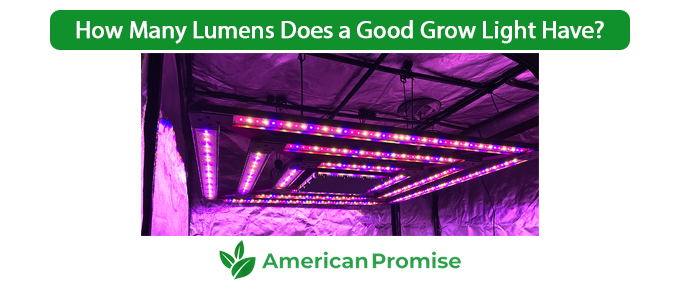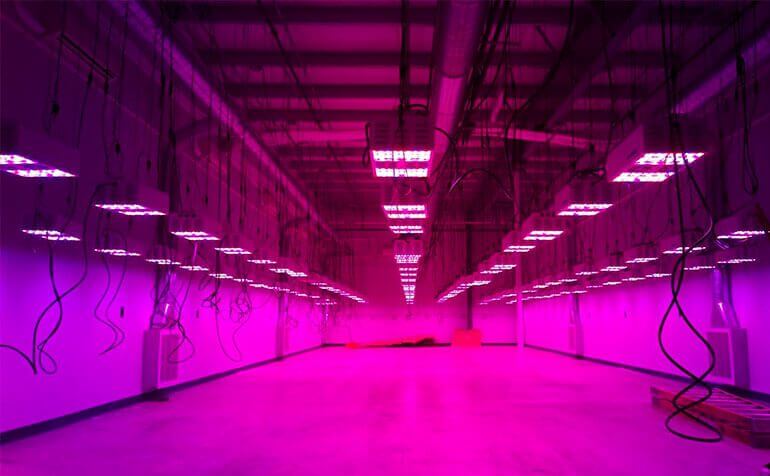We occasionally recommend products we love and might be paid a share of the sale.
Growing any kind of indoor plant is a hassle, especially if you don’t know the exact measurements of things and the kind of quantity that you need to rely on. If you are in the same boat and you have started an indoor grow room, being confused about the grow lights is common.
However, what you need to realize is that the correct intensity of the large LED grow lights for your plants is crucial. Not being able to maintain the correct intensity of grow lights will hamper the growth and prevent it from flourishing the way you’d expect.
One crucial part of a grow light is how many lumens it is. If you are confused about the whole charade, this article should answer all your queries in detail.
What is a Lumen?
If you are dealing with grow lights for the first time, not knowing what a lumen is a common thing. Be assured that a lumen is defined as the amount of light that is emitted per second from any kind of light source. This is what determines the intensity of the light source.
While understanding the concept of the lumen can be a pretty straightforward thing, you’d be quite confused about unfurling the same when it comes to grow lights.
What you need to understand is the kind of intensity that is needed for plant growth. If your plant needs optimal exposure for prolonged and uninterrupted growth, you need to ensure that your grow light has the required lumens of light for the same.
When it comes to deciding the optimal lumens for plant growth in a grow room, you need to ensure that your LED lights in the grow light setting has enough intensity to kickstart the process of photosynthesis. This is a good base point to get started with.
Does Lumen differ from Watt?
When you come to think of a light, the first unit that anyone associates with the same is that of Wattage. And, for you to think about the same is a common occurrence.
However, a Watt is defined as the measure of energy consumption when electricity is passing through the bulb. So, unlike lumen, it isn’t associated with the light’s intensity, which means that it has no possible correlation with how it affects the plant’s growth in the long run.
What is the correlation or difference between Useful Lumens and Wasted Lumens?
Now that you have a basic understanding of lumens and what it entails in terms of grow lights and plant growth, we must discuss the difference between useful lumens and wasted lumens.
Like any kind of energy source, the light that is exposed to the plants isn’t taken up by the plant as a whole. This means that there is some level of produced lumens from the LED grow lights that are wasted out. Some of the light will either get wasted out of the side while a few others will not be optimally absorbed in by the plants.
So, you need to keep in mind that some part of the grow light exposure will be wasted, which is what we discuss as the wasted lumens. On the other hand, the lumens that are being used by the plant to promote its growth are termed useful lumens.
How does the Lumens Affect Plant Growth?
With the basic understanding of things out of the way, you must be sitting here concerned about the correlation between lumens and plant growth.
After all, how does light exposure promote or affect plant growth?
Keep in mind that when you are growing plants indoors or in a grow room; they still require sunlight exposure for growth and to prosper. The grow lights act as the source of sunlight in this case.
So, if you don’t manage the optimal levels of exposure of the light on the plant, the same will eventually end up causing utter chaos for you. Just be assured that while less is bad, anything in excess is equally bad as well.
For the healthy growth of the plants, the must grow light exposure is managed and controlled as well. Optimizing and regulating the correct exposure of the grow lights for the plants reflect in proper growth indoors.
How many Lumens is an optimal per plant?
When it comes to growing plants indoors, being vigilant about the lumens of the grow light is important. But, how much is too much? This is a question that haunts several users. What you need to realize is that there is not one standard option.
Typically, it depends on the kind of plant you are growing, the kind of space you have available in your grow rooms and the kind of requirements that the plants have.
Especially during the winters when the outdoor season and the living conditions become inhabitable, it becomes a lot easier when you shift the plants indoors.
However, being aware of the lumens requirement makes the process a lot easier for you. Typically, these are some pointers you should be aware of:
- The starting range is 2000 lumens per square foot for any kind of plant that requires minimum light exposure.
- The optimal lumen range is between 6500 to 7500 per square foot for the majority of the indoor plants that you grow.
- The plants with medium lighting requirements range between 5000-5500 lumens per square foot.
- The plants require less lumen exposure (between 2000 to 3000 lumens) during vegetative stages and require more exposure (between 5000 to 10,000 lumens) during the flowering stages.
Keep in mind that these are rough calculations and will vary depending on the kind of plants you are growing and the available space indoors.
What kind of lumens do the grow lights produce?
There are a bunch of different types of grow lights available in the market. The intensity depends on the kind of wattage the lights have.
Typically, the HPS grow lights, which are the cheaper ones produce around 100 lumens per watt. The LED grow lights are superior options and produce around 300 lumens per watt and have higher intensity in comparison.
How long should One Expose the LED grow lights?
Now that you have a basic understanding of the lumens and the exposure to light, you must discuss the duration.
For how long should you leave the grow lights on?
Typically, the duration of the grow lights depends on the type of plant. The vegetable and the flowering plants require up to 18 hours of exposure. However, if you are growing flowering plants, they can work with 12 hours of grow light exposure.
When looking into the duration, always confirm the intensity and the optimal lumens the plants require for uninterrupted growth. This is something you just can’t brush aside at all.
Should you forget lumens when buying grow lights?
With the kind of confusion that grow lights bring, it isn’t surprising that more and more individuals are inquisitive about its effectiveness.
What you need to realize is the fact that although quite confusing, addressing the importance of lumens is important. You need to know this to ensure the optimal growth of your plants.
Technically, the right exposure of light on the indoor plants for an optimal period is what deduces the effectiveness of the growth of the individual plants. If they aren’t getting the right kind of light exposure, the same will end up reflecting on the plant’s growth.
Similarly, too much exposure will turn the leaves brown and kill them even before you can nod hello to the yield. So, yes, being mindful of the lumens is a necessity and not just something you can brush aside and call a day.
Typically, being mindful of the lumens according to the plant’s requirements is what matters at the end of the day. You want to ensure that the plant is getting just the right amount of exposure like it needs.
How many lumens is direct sunlight?
You can’t deny the fact that direct sunlight is the ultimate source of light energy that the plant needs to grow without any inhibition. However, what you need to realize is the fact that getting direct sunlight is not always possible, especially when it comes to indoor growing.
This is where the artificial grow lights come into play.
Direct sunlight is equivalent to 93 lumens per watt of radiant flux. However, when it comes to deducing the intensity in terms of area, it reflects 98000 lux on a perpendicular surface.
Conclusion
Choosing a random set of grow lights is not ideal for plant growth indoors. Not only do you need to be mindful of the quality of the grow lights, but you also need to find out the optimal lumens of the light exposure needed by the grow lights. This is what makes all the difference in the world. So, once you figure out how much light exposure your plant needs, it becomes smooth sailing from there.
I’m an avid gardener and cannabis enthusiast. You can usually find me in my garden caring for my plants or at my computer crafting helpful blogs for my readers.
Contents




